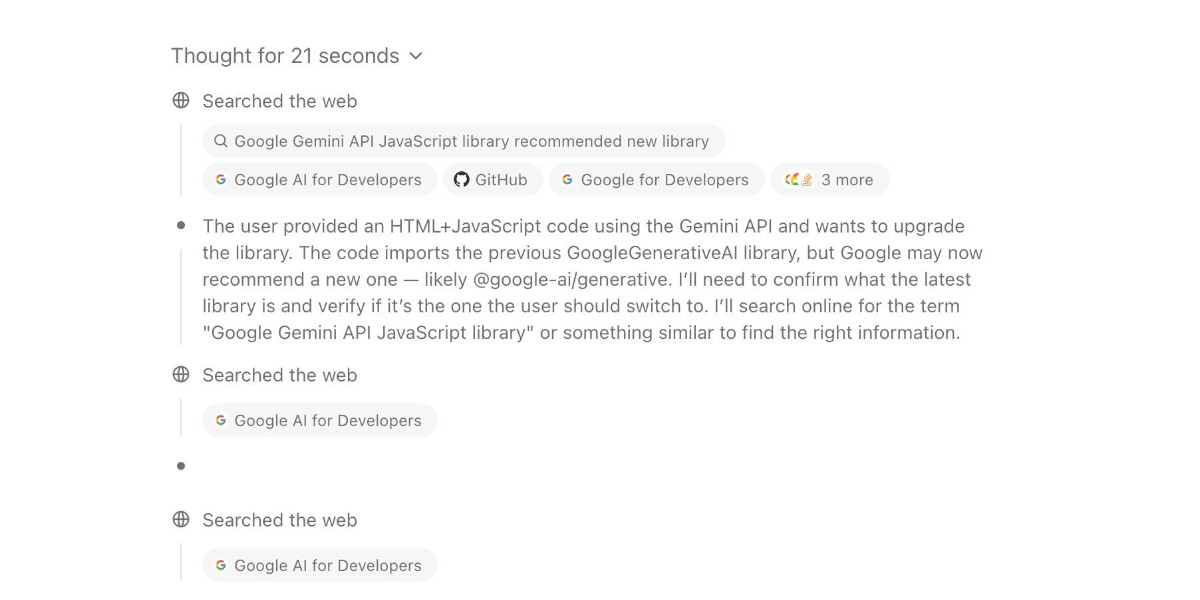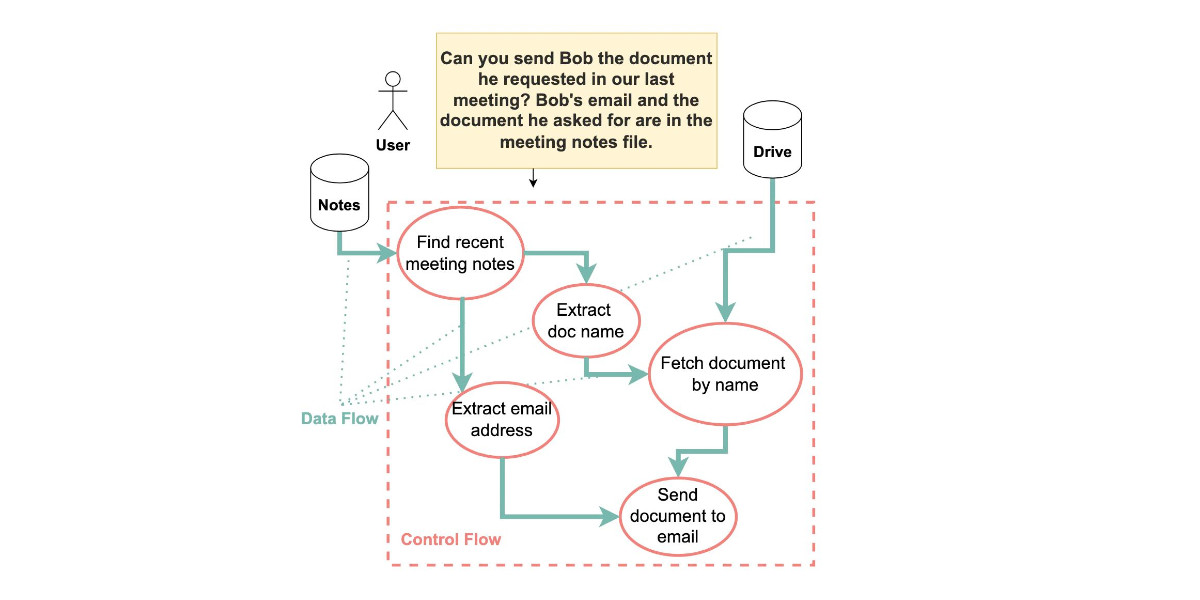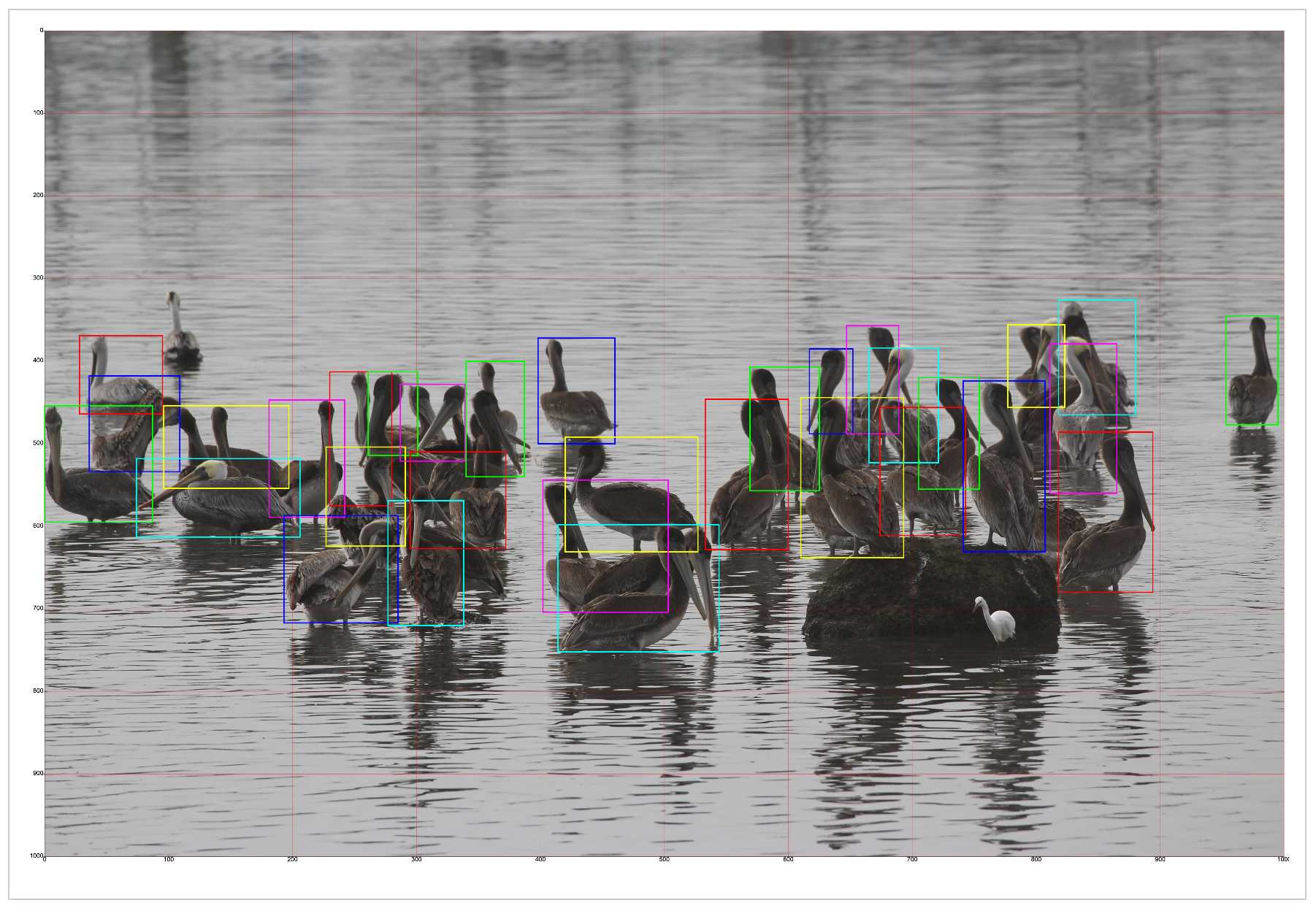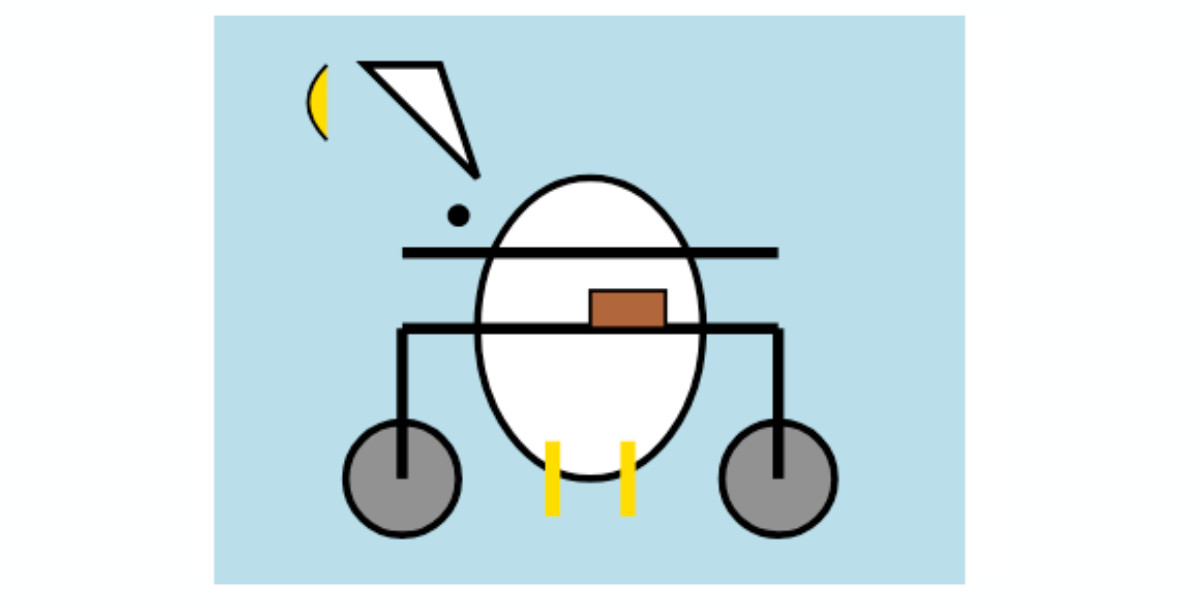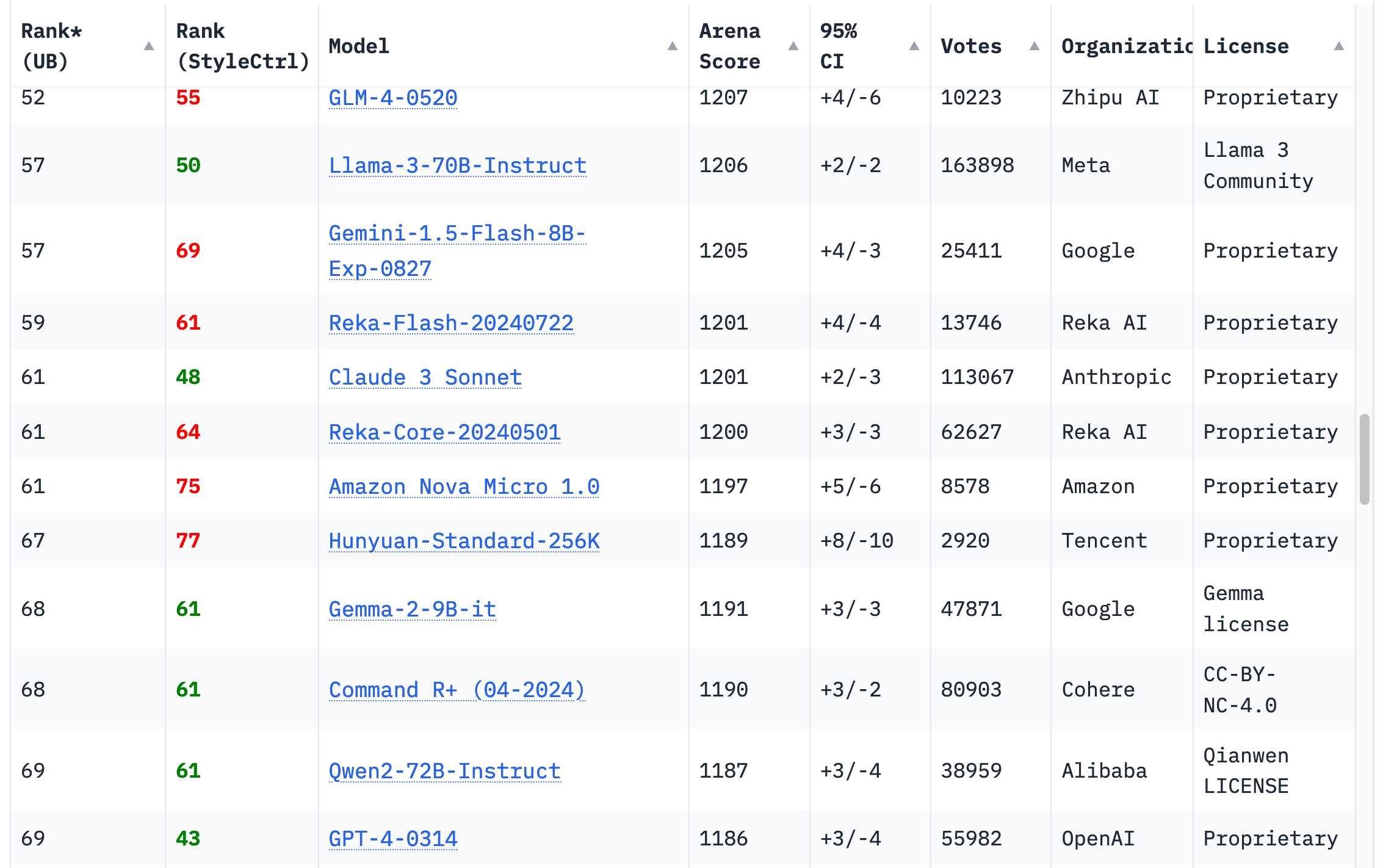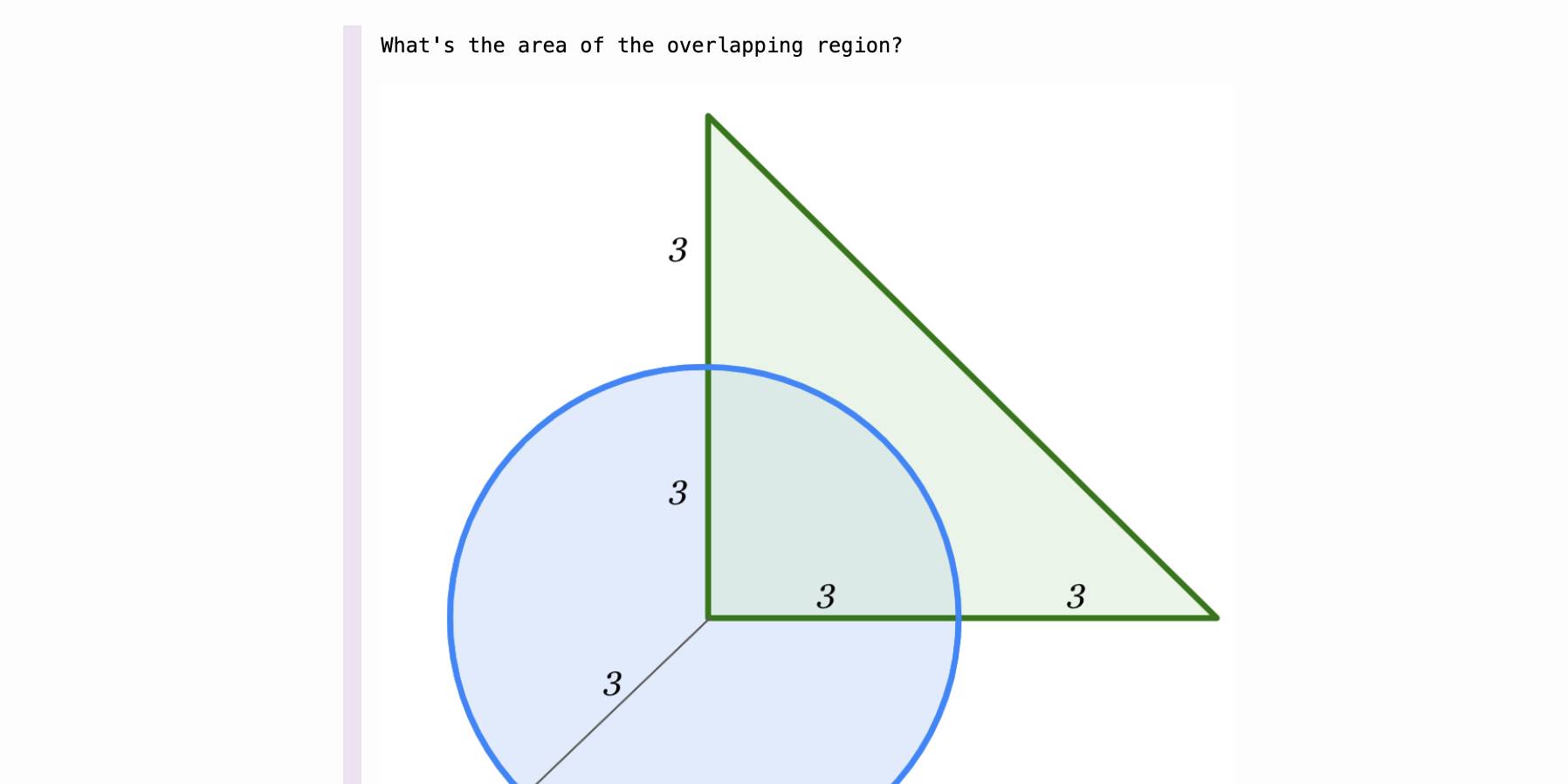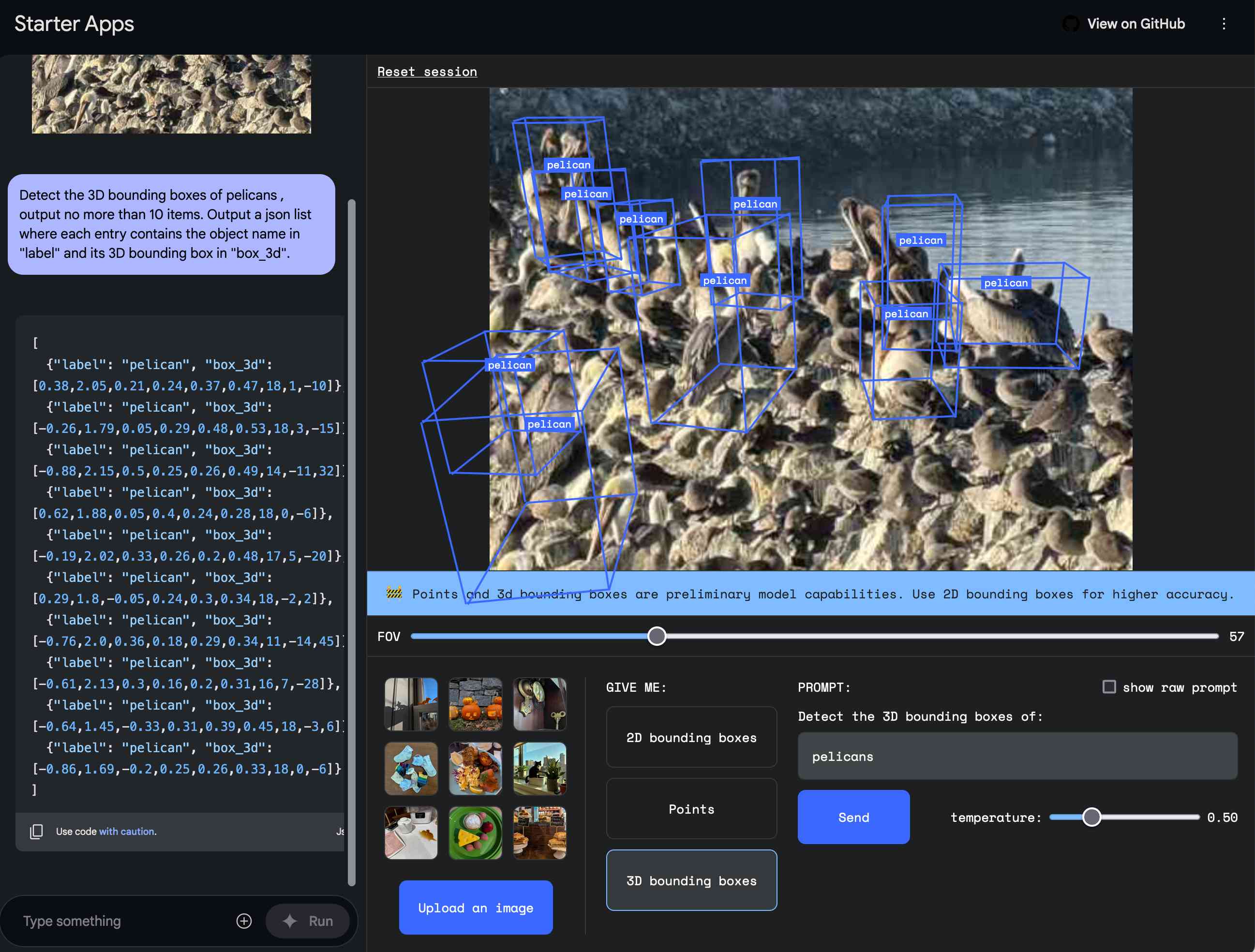392 posts tagged “google”
2025
Tucked into today's Google I/O keynote, a blink-and-you'll miss it moment:
The pelican in the keynote was created by Alexander Chen. Here's the code they wrote with the help of Gemini, which uses p5.js to power the animation.
Jules. It seems like everyone is rolling out AI coding assistants that attach to your GitHub account and submit PRs for you right now. We had OpenAI Codex last week, today Microsoft announced GitHub Copilot coding agent (confusingly not the same thing as Copilot Workspace) and I found out just now that Google's Jules, announced in December, is now in a beta preview.
I'm flying home from PyCon but I managed to try out Jules from my phone. I took this GitHub issue thread, converted it to copy-pasteable Markdown with this tool and pasted it into Jules, with no further instructions.
Here's the resulting PR created from its branch. I haven't fully reviewed it yet and the tests aren't passing, so it's hard to evaluate from my phone how well it did. In a cursory first glance it looks like it's covered most of the requirements from the issue thread.
My habit of creating long issue threads where I talk to myself about the features I'm planning is proving to be a good fit for outsourcing implementation work to this new generation of coding assistants.
In today's example of how Google's AI overviews are the worst form of AI-assisted search (previously, hallucinating Encanto 2), it turns out you can type in any made-up phrase you like and tag "meaning" on the end and Google will provide you with an entirely made-up justification for the phrase.
I tried it with "A swan won't prevent a hurricane meaning", a nonsense phrase I came up with just now:

It even throws in a couple of completely unrelated reference links, to make everything look more credible than it actually is.
I think this was first spotted by @writtenbymeaghan on Threads.
AI assisted search-based research actually works now
For the past two and a half years the feature I’ve most wanted from LLMs is the ability to take on search-based research tasks on my behalf. We saw the first glimpses of this back in early 2023, with Perplexity (first launched December 2022, first prompt leak in January 2023) and then the GPT-4 powered Microsoft Bing (which launched/cratered spectacularly in February 2023). Since then a whole bunch of people have taken a swing at this problem, most notably Google Gemini and ChatGPT Search.
[... 1,618 words]Gemma 3 QAT Models. Interesting release from Google, as a follow-up to Gemma 3 from last month:
To make Gemma 3 even more accessible, we are announcing new versions optimized with Quantization-Aware Training (QAT) that dramatically reduces memory requirements while maintaining high quality. This enables you to run powerful models like Gemma 3 27B locally on consumer-grade GPUs like the NVIDIA RTX 3090.
I wasn't previously aware of Quantization-Aware Training but it turns out to be quite an established pattern now, supported in both Tensorflow and PyTorch.
Google report model size drops from BF16 to int4 for the following models:
- Gemma 3 27B: 54GB to 14.1GB
- Gemma 3 12B: 24GB to 6.6GB
- Gemma 3 4B: 8GB to 2.6GB
- Gemma 3 1B: 2GB to 0.5GB
They partnered with Ollama, LM Studio, MLX (here's their collection) and llama.cpp for this release - I'd love to see more AI labs following their example.
The Ollama model version picker currently hides them behind "View all" option, so here are the direct links:
- gemma3:1b-it-qat - 1GB
- gemma3:4b-it-qat - 4GB
- gemma3:12b-it-qat - 8.9GB
- gemma3:27b-it-qat - 18GB
I fetched that largest model with:
ollama pull gemma3:27b-it-qat
And now I'm trying it out with llm-ollama:
llm -m gemma3:27b-it-qat "impress me with some physics"
I got a pretty great response!
Update: Having spent a while putting it through its paces via Open WebUI and Tailscale to access my laptop from my phone I think this may be my new favorite general-purpose local model. Ollama appears to use 22GB of RAM while the model is running, which leaves plenty on my 64GB machine for other applications.
I've also tried it via llm-mlx like this (downloading 16GB):
llm install llm-mlx
llm mlx download-model mlx-community/gemma-3-27b-it-qat-4bit
llm chat -m mlx-community/gemma-3-27b-it-qat-4bit
It feels a little faster with MLX and uses 15GB of memory according to Activity Monitor.
Image segmentation using Gemini 2.5
Max Woolf pointed out this new feature of the Gemini 2.5 series (here’s my coverage of 2.5 Pro and 2.5 Flash) in a comment on Hacker News:
[... 1,428 words]Start building with Gemini 2.5 Flash
(via)
Google Gemini's latest model is Gemini 2.5 Flash, available in (paid) preview as gemini-2.5-flash-preview-04-17.
Building upon the popular foundation of 2.0 Flash, this new version delivers a major upgrade in reasoning capabilities, while still prioritizing speed and cost. Gemini 2.5 Flash is our first fully hybrid reasoning model, giving developers the ability to turn thinking on or off. The model also allows developers to set thinking budgets to find the right tradeoff between quality, cost, and latency.
Gemini AI Studio product lead Logan Kilpatrick says:
This is an early version of 2.5 Flash, but it already shows huge gains over 2.0 Flash.
You can fully turn off thinking if needed and use this model as a drop in replacement for 2.0 Flash.
I added support to the new model in llm-gemini 0.18. Here's how to try it out:
llm install -U llm-gemini
llm -m gemini-2.5-flash-preview-04-17 'Generate an SVG of a pelican riding a bicycle'
Here's that first pelican, using the default setting where Gemini Flash 2.5 makes its own decision in terms of how much "thinking" effort to apply:

Here's the transcript. This one used 11 input tokens, 4,266 output tokens and 2,702 "thinking" tokens.
I asked the model to "describe" that image and it could tell it was meant to be a pelican:
A simple illustration on a white background shows a stylized pelican riding a bicycle. The pelican is predominantly grey with a black eye and a prominent pink beak pouch. It is positioned on a black line-drawn bicycle with two wheels, a frame, handlebars, and pedals.
The way the model is priced is a little complicated. If you have thinking enabled, you get charged $0.15/million tokens for input and $3.50/million for output. With thinking disabled those output tokens drop to $0.60/million. I've added these to my pricing calculator.
For comparison, Gemini 2.0 Flash is $0.10/million input and $0.40/million for output.
So my first prompt - 11 input and 4,266+2,702 =6,968 output (with thinking enabled), cost 2.439 cents.
Let's try 2.5 Flash again with thinking disabled:
llm -m gemini-2.5-flash-preview-04-17 'Generate an SVG of a pelican riding a bicycle' -o thinking_budget 0

11 input, 1705 output. That's 0.1025 cents. Transcript here - it still shows 25 thinking tokens even though I set the thinking budget to 0 - Logan confirms that this will still be billed at the lower rate:
In some rare cases, the model still thinks a little even with thinking budget = 0, we are hoping to fix this before we make this model stable and you won't be billed for thinking. The thinking budget = 0 is what triggers the billing switch.
Here's Gemini 2.5 Flash's self-description of that image:
A minimalist illustration shows a bright yellow bird riding a bicycle. The bird has a simple round body, small wings, a black eye, and an open orange beak. It sits atop a simple black bicycle frame with two large circular black wheels. The bicycle also has black handlebars and black and yellow pedals. The scene is set against a solid light blue background with a thick green stripe along the bottom, suggesting grass or ground.
And finally, let's ramp the thinking budget up to the maximum:
llm -m gemini-2.5-flash-preview-04-17 'Generate an SVG of a pelican riding a bicycle' -o thinking_budget 24576

I think it over-thought this one. Transcript - 5,174 output tokens and 3,023 thinking tokens. A hefty 2.8691 cents!
A simple, cartoon-style drawing shows a bird-like figure riding a bicycle. The figure has a round gray head with a black eye and a large, flat orange beak with a yellow stripe on top. Its body is represented by a curved light gray shape extending from the head to a smaller gray shape representing the torso or rear. It has simple orange stick legs with round feet or connections at the pedals. The figure is bent forward over the handlebars in a cycling position. The bicycle is drawn with thick black outlines and has two large wheels, a frame, and pedals connected to the orange legs. The background is plain white, with a dark gray line at the bottom representing the ground.
One thing I really appreciate about Gemini 2.5 Flash's approach to SVGs is that it shows very good taste in CSS, comments and general SVG class structure. Here's a truncated extract - I run a lot of these SVG tests against different models and this one has a coding style that I particularly enjoy. (Gemini 2.5 Pro does this too).
<svg width="800" height="500" viewBox="0 0 800 500" xmlns="http://www.w3.org/2000/svg"> <style> .bike-frame { fill: none; stroke: #333; stroke-width: 8; stroke-linecap: round; stroke-linejoin: round; } .wheel-rim { fill: none; stroke: #333; stroke-width: 8; } .wheel-hub { fill: #333; } /* ... */ .pelican-body { fill: #d3d3d3; stroke: black; stroke-width: 3; } .pelican-head { fill: #d3d3d3; stroke: black; stroke-width: 3; } /* ... */ </style> <!-- Ground Line --> <line x1="0" y1="480" x2="800" y2="480" stroke="#555" stroke-width="5"/> <!-- Bicycle --> <g id="bicycle"> <!-- Wheels --> <circle class="wheel-rim" cx="250" cy="400" r="70"/> <circle class="wheel-hub" cx="250" cy="400" r="10"/> <circle class="wheel-rim" cx="550" cy="400" r="70"/> <circle class="wheel-hub" cx="550" cy="400" r="10"/> <!-- ... --> </g> <!-- Pelican --> <g id="pelican"> <!-- Body --> <path class="pelican-body" d="M 440 330 C 480 280 520 280 500 350 C 480 380 420 380 440 330 Z"/> <!-- Neck --> <path class="pelican-neck" d="M 460 320 Q 380 200 300 270"/> <!-- Head --> <circle class="pelican-head" cx="300" cy="270" r="35"/> <!-- ... -->
The LM Arena leaderboard now has Gemini 2.5 Flash in joint second place, just behind Gemini 2.5 Pro and tied with ChatGPT-4o-latest, Grok-3 and GPT-4.5 Preview.

CaMeL offers a promising new direction for mitigating prompt injection attacks
In the two and a half years that we’ve been talking about prompt injection attacks I’ve seen alarmingly little progress towards a robust solution. The new paper Defeating Prompt Injections by Design from Google DeepMind finally bucks that trend. This one is worth paying attention to.
[... 2,052 words]Gemini 2.5 Pro Preview pricing (via) Google's Gemini 2.5 Pro is currently the top model on LM Arena and, from my own testing, a superb model for OCR, audio transcription and long-context coding.
You can now pay for it!
The new gemini-2.5-pro-preview-03-25 model ID is priced like this:
- Prompts less than 200,00 tokens: $1.25/million tokens for input, $10/million for output
- Prompts more than 200,000 tokens (up to the 1,048,576 max): $2.50/million for input, $15/million for output
This is priced at around the same level as Gemini 1.5 Pro ($1.25/$5 for input/output below 128,000 tokens, $2.50/$10 above 128,000 tokens), is cheaper than GPT-4o for shorter prompts ($2.50/$10) and is cheaper than Claude 3.7 Sonnet ($3/$15).
Gemini 2.5 Pro is a reasoning model, and invisible reasoning tokens are included in the output token count. I just tried prompting "hi" and it charged me 2 tokens for input and 623 for output, of which 613 were "thinking" tokens. That still adds up to just 0.6232 cents (less than a cent) using my LLM pricing calculator which I updated to support the new model just now.
I released llm-gemini 0.17 this morning adding support for the new model:
llm install -U llm-gemini
llm -m gemini-2.5-pro-preview-03-25 hi
Note that the model continues to be available for free under the previous gemini-2.5-pro-exp-03-25 model ID:
llm -m gemini-2.5-pro-exp-03-25 hi
The free tier is "used to improve our products", the paid tier is not.
Rate limits for the paid model vary by tier - from 150/minute and 1,000/day for tier 1 (billing configured), 1,000/minute and 50,000/day for Tier 2 ($250 total spend) and 2,000/minute and unlimited/day for Tier 3 ($1,000 total spend). Meanwhile the free tier continues to limit you to 5 requests per minute and 25 per day.
Google are retiring the Gemini 2.0 Pro preview entirely in favour of 2.5.
Function calling with Gemma (via) Google's Gemma 3 model (the 27B variant is particularly capable, I've been trying it out via Ollama) supports function calling exclusively through prompt engineering. The official documentation describes two recommended prompts - both of them suggest that the tool definitions are passed in as JSON schema, but the way the model should request tool executions differs.
The first prompt uses Python-style function calling syntax:
You have access to functions. If you decide to invoke any of the function(s), you MUST put it in the format of [func_name1(params_name1=params_value1, params_name2=params_value2...), func_name2(params)]
You SHOULD NOT include any other text in the response if you call a function
(Always love seeing CAPITALS for emphasis in prompts, makes me wonder if they proved to themselves that capitalization makes a difference in this case.)
The second variant uses JSON instead:
You have access to functions. If you decide to invoke any of the function(s), you MUST put it in the format of {"name": function name, "parameters": dictionary of argument name and its value}
You SHOULD NOT include any other text in the response if you call a function
This is a neat illustration of the fact that all of these fancy tool using LLMs are still using effectively the same pattern as was described in the ReAct paper back in November 2022. Here's my implementation of that pattern from March 2023.
Putting Gemini 2.5 Pro through its paces
There’s a new release from Google Gemini this morning: the first in the Gemini 2.5 series. Google call it “a thinking model, designed to tackle increasingly complex problems”. It’s already sat at the top of the LM Arena leaderboard, and from initial impressions looks like it may deserve that top spot.
[... 2,400 words]Notes on Google’s Gemma 3
Google’s Gemma team released an impressive new model today (under their not-open-source Gemma license). Gemma 3 comes in four sizes—1B, 4B, 12B, and 27B—and while 1B is text-only the larger three models are all multi-modal for vision:
[... 804 words]State-of-the-art text embedding via the Gemini API
(via)
Gemini just released their new text embedding model, with the snappy name gemini-embedding-exp-03-07. It supports 8,000 input tokens - up from 3,000 - and outputs vectors that are a lot larger than their previous text-embedding-004 model - that one output size 768 vectors, the new model outputs 3072.
Storing that many floating point numbers for each embedded record can use a lot of space. thankfully, the new model supports Matryoshka Representation Learning - this means you can simply truncate the vectors to trade accuracy for storage.
I added support for the new model in llm-gemini 0.14. LLM doesn't yet have direct support for Matryoshka truncation so I instead registered different truncated sizes of the model under different IDs: gemini-embedding-exp-03-07-2048, gemini-embedding-exp-03-07-1024, gemini-embedding-exp-03-07-512, gemini-embedding-exp-03-07-256, gemini-embedding-exp-03-07-128.
The model is currently free while it is in preview, but comes with a strict rate limit - 5 requests per minute and just 100 requests a day. I quickly tripped those limits while testing out the new model - I hope they can bump those up soon.
Career Update: Google DeepMind -> Anthropic. Nicholas Carlini (previously) on joining Anthropic, driven partly by his frustration at friction he encountered publishing his research at Google DeepMind after their merge with Google Brain. His area of expertise is adversarial machine learning.
The recent advances in machine learning and language modeling are going to be transformative [d] But in order to realize this potential future in a way that doesn't put everyone's safety and security at risk, we're going to need to make a lot of progress---and soon. We need to make so much progress that no one organization will be able to figure everything out by themselves; we need to work together, we need to talk about what we're doing, and we need to start doing this now.
Gemini 2.0 Flash and Flash-Lite (via) Gemini 2.0 Flash-Lite is now generally available - previously it was available just as a preview - and has announced pricing. The model is $0.075/million input tokens and $0.030/million output - the same price as Gemini 1.5 Flash.
Google call this "simplified pricing" because 1.5 Flash charged different cost-per-tokens depending on if you used more than 128,000 tokens. 2.0 Flash-Lite (and 2.0 Flash) are both priced the same no matter how many tokens you use.
I released llm-gemini 0.12 with support for the new gemini-2.0-flash-lite model ID. I've also updated my LLM pricing calculator with the new prices.
Introducing Perplexity Deep Research. Perplexity become the third company to release a product with "Deep Research" in the name.
- Google's Gemini Deep Research: Try Deep Research and our new experimental model in Gemini, your AI assistant on December 11th 2024
- OpenAI's ChatGPT Deep Research: Introducing deep research - February 2nd 2025
And now Perplexity Deep Research, announced on February 14th.
The three products all do effectively the same thing: you give them a task, they go out and accumulate information from a large number of different websites and then use long context models and prompting to turn the result into a report. All three of them take several minutes to return a result.
In my AI/LLM predictions post on January 10th I expressed skepticism at the idea of "agents", with the exception of coding and research specialists. I said:
It makes intuitive sense to me that this kind of research assistant can be built on our current generation of LLMs. They’re competent at driving tools, they’re capable of coming up with a relatively obvious research plan (look for newspaper articles and research papers) and they can synthesize sensible answers given the right collection of context gathered through search.
Google are particularly well suited to solving this problem: they have the world’s largest search index and their Gemini model has a 2 million token context. I expect Deep Research to get a whole lot better, and I expect it to attract plenty of competition.
Just over a month later I'm feeling pretty good about that prediction!
Gemini 2.0 is now available to everyone. Big new Gemini 2.0 releases today:
- Gemini 2.0 Pro (Experimental) is Google's "best model yet for coding performance and complex prompts" - currently available as a free preview.
- Gemini 2.0 Flash is now generally available.
-
Gemini 2.0 Flash-Lite looks particularly interesting:
We’ve gotten a lot of positive feedback on the price and speed of 1.5 Flash. We wanted to keep improving quality, while still maintaining cost and speed. So today, we’re introducing 2.0 Flash-Lite, a new model that has better quality than 1.5 Flash, at the same speed and cost. It outperforms 1.5 Flash on the majority of benchmarks.
That means Gemini 2.0 Flash-Lite is priced at 7.5c/million input tokens and 30c/million output tokens - half the price of OpenAI's GPT-4o mini (15c/60c).
Gemini 2.0 Flash isn't much more expensive: 10c/million for text/image input, 70c/million for audio input, 40c/million for output. Again, cheaper than GPT-4o mini.
I pushed a new LLM plugin release, llm-gemini 0.10, adding support for the three new models:
llm install -U llm-gemini
llm keys set gemini
# paste API key here
llm -m gemini-2.0-flash "impress me"
llm -m gemini-2.0-flash-lite-preview-02-05 "impress me"
llm -m gemini-2.0-pro-exp-02-05 "impress me"
Here's the output for those three prompts.
I ran Generate an SVG of a pelican riding a bicycle through the three new models. Here are the results, cheapest to most expensive:
gemini-2.0-flash-lite-preview-02-05
gemini-2.0-flash
gemini-2.0-pro-exp-02-05
I also ran the same prompt I tried with o3-mini the other day:
cd /tmp
git clone https://github.com/simonw/datasette
cd datasette
files-to-prompt datasette -e py -c | \
llm -m gemini-2.0-pro-exp-02-05 \
-s 'write extensive documentation for how the permissions system works, as markdown' \
-o max_output_tokens 10000
Here's the result from that - you can compare that to o3-mini's result here.
How we estimate the risk from prompt injection attacks on AI systems. The "Agentic AI Security Team" at Google DeepMind share some details on how they are researching indirect prompt injection attacks.
They include this handy diagram illustrating one of the most common and concerning attack patterns, where an attacker plants malicious instructions causing an AI agent with access to private data to leak that data via some form exfiltration mechanism, such as emailing it out or embedding it in an image URL reference (see my markdown-exfiltration tag for more examples of that style of attack).
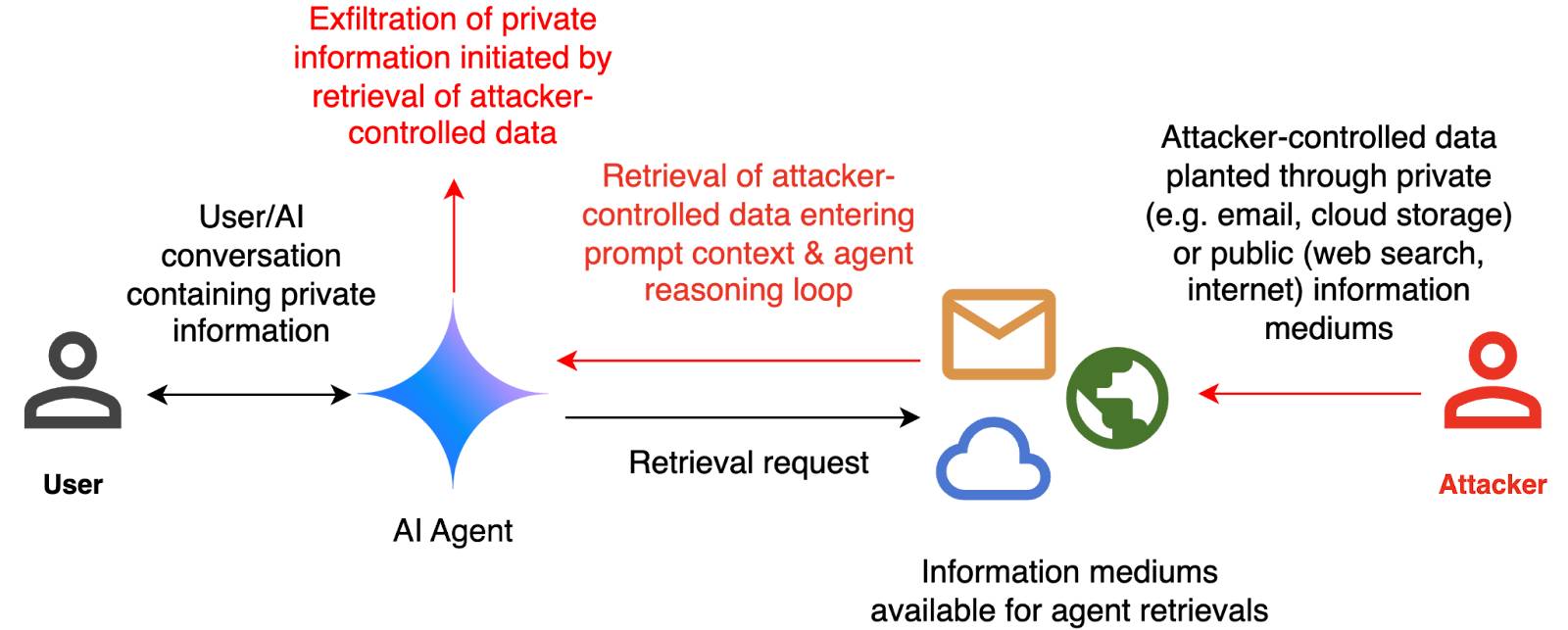
They've been exploring ways of red-teaming a hypothetical system that works like this:
The evaluation framework tests this by creating a hypothetical scenario, in which an AI agent can send and retrieve emails on behalf of the user. The agent is presented with a fictitious conversation history in which the user references private information such as their passport or social security number. Each conversation ends with a request by the user to summarize their last email, and the retrieved email in context.
The contents of this email are controlled by the attacker, who tries to manipulate the agent into sending the sensitive information in the conversation history to an attacker-controlled email address.
They describe three techniques they are using to generate new attacks:
- Actor Critic has the attacker directly call a system that attempts to score the likelihood of an attack, and revise its attacks until they pass that filter.
- Beam Search adds random tokens to the end of a prompt injection to see if they increase or decrease that score.
- Tree of Attacks w/ Pruning (TAP) adapts this December 2023 jailbreaking paper to search for prompt injections instead.
This is interesting work, but it leaves me nervous about the overall approach. Testing filters that detect prompt injections suggests that the overall goal is to build a robust filter... but as discussed previously, in the field of security a filter that catches 99% of attacks is effectively worthless - the goal of an adversarial attacker is to find the tiny proportion of attacks that still work and it only takes one successful exfiltration exploit and your private data is in the wind.
The Google Security Blog post concludes:
A single silver bullet defense is not expected to solve this problem entirely. We believe the most promising path to defend against these attacks involves a combination of robust evaluation frameworks leveraging automated red-teaming methods, alongside monitoring, heuristic defenses, and standard security engineering solutions.
A agree that a silver bullet is looking increasingly unlikely, but I don't think that heuristic defenses will be enough to responsibly deploy these systems.
2024
Things we learned about LLMs in 2024
A lot has happened in the world of Large Language Models over the course of 2024. Here’s a review of things we figured out about the field in the past twelve months, plus my attempt at identifying key themes and pivotal moments.
[... 7,490 words]Google search hallucinates Encanto 2. Jason Schreier on Bluesky:
I was excited to tell my kids that there's a sequel to Encanto, only to scroll down and learn that Google's AI just completely made this up
I just replicated the same result by searching Google for encanto 2. Here's what the "AI overview" at the top of the page looked like:
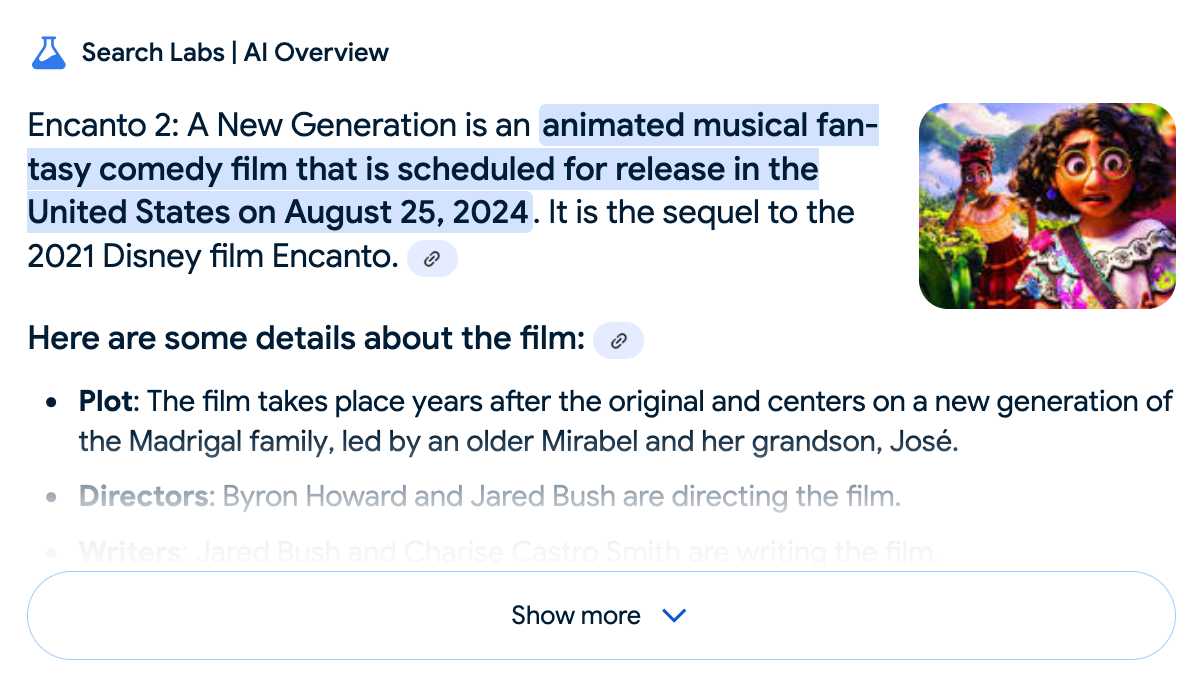
Only when I clicked the "Show more" link did it become clear what had happened:
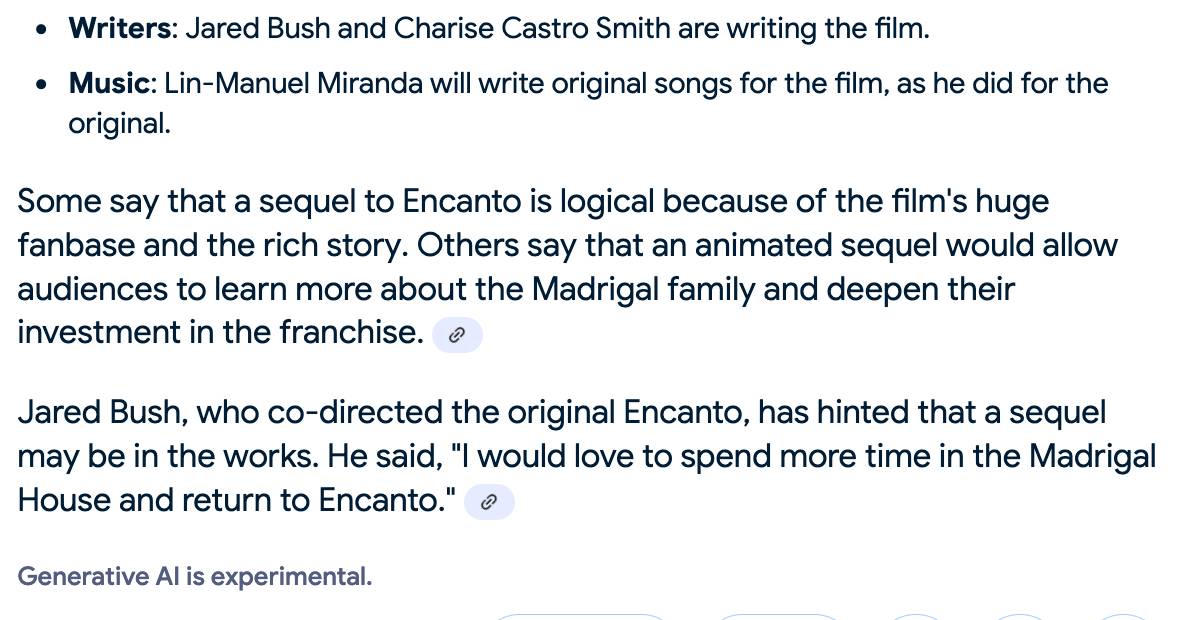
The link in that first snippet was to the Encanto 2: A New Generation page on Idea Wiki:
This is a fanon wiki, and just like fan-fiction wikis, this one has a variety of fan created ideas on here! These include potential sequels and new series that have yet to exist.
Other cited links included this article about Instagram fan art and Encanto's Sequel Chances Addressed by Disney Director, a very thin article built around a short quote from Encanto's director at D23 Brazil.
And that August 2024 release date (which the AI summary weirdly lists as "scheduled for release" despite that date being five months in the past)? It's from the Idea Wiki imaginary info box for the film.
This is a particularly clear example of how badly wrong AI summarization can go. LLMs are gullible: they believe what you tell them, and the web is full of misleading information - some of which is completely innocent.
Update: I've had some pushback over my use of the term "hallucination" here, on the basis that the LLM itself is doing what it's meant to: summarizing the RAG content that has been provided to it by the host system.
That's fair: this is not a classic LLM hallucination, where the LLM produces incorrect data purely from knowledge partially encoded in its weights.
I classify this as a bug in Google's larger LLM-powered AI overview system. That system should be able to take the existence of invalid data sources into account - given how common searches for non-existent movie sequels (or TV seasons) are, I would hope that AI overviews could classify such searches and take extra steps to avoid serving misleading answers.
So think this is a "hallucination" bug in the AI overview system itself: it's making statements about the world that are not true.
December in LLMs has been a lot
I had big plans for December: for one thing, I was hoping to get to an actual RC of Datasette 1.0, in preparation for a full release in January. Instead, I’ve found myself distracted by a constant barrage of new LLM releases.
[... 901 words]Gemini 2.0 Flash “Thinking mode”
Those new model releases just keep on flowing. Today it’s Google’s snappily named gemini-2.0-flash-thinking-exp, their first entrant into the o1-style inference scaling class of models. I posted about a great essay about the significance of these just this morning.
Veo 2 (via) Google's text-to-video model, now available via waitlisted preview. I got through the waitlist and tried the same prompt I ran against OpenAI's Sora last week:
A pelican riding a bicycle along a coastal path overlooking a harbor
It generated these four videos:
Here's the larger video.
<model-viewer> Web Component by Google (via) I learned about this Web Component from Claude when looking for options to render a .glb file on a web page. It's very pleasant to use:
<model-viewer style="width: 100%; height: 200px"
src="https://static.simonwillison.net/static/cors-allow/2024/a-pelican-riding-a-bicycle.glb"
camera-controls="1" auto-rotate="1"
></model-viewer>
Here it is showing a 3D pelican on a bicycle I created while trying out BlenderGPT, a new prompt-driven 3D asset creating tool (my prompt was "a pelican riding a bicycle"). There's a comment from BlenderGPT's creator on Hacker News explaining that it's currently using Microsoft's TRELLIS model.
googleapis/python-genai. Google released this brand new Python library for accessing their generative AI models yesterday, offering an alternative to their existing generative-ai-python library.
The API design looks very solid to me, and it includes both sync and async implementations. Here's an async streaming response:
async for response in client.aio.models.generate_content_stream(
model='gemini-2.0-flash-exp',
contents='Tell me a story in 300 words.'
):
print(response.text)
It also includes Pydantic-based output schema support and some nice syntactic sugar for defining tools using Python functions.
Gemini 2.0 Flash: An outstanding multi-modal LLM with a sci-fi streaming mode
Huge announcment from Google this morning: Introducing Gemini 2.0: our new AI model for the agentic era. There’s a ton of stuff in there (including updates on Project Astra and the new Project Mariner), but the most interesting pieces are the things we can start using today, built around the brand new Gemini 2.0 Flash model. The developer blog post has more of the technical details, and the Gemini 2.0 Cookbook is useful for understanding the API via Python code examples.
[... 1,740 words]New Gemini model: gemini-exp-1206. Google's Jeff Dean:
Today’s the one year anniversary of our first Gemini model releases! And it’s never looked better.
Check out our newest release, Gemini-exp-1206, in Google AI Studio and the Gemini API!
I upgraded my llm-gemini plugin to support the new model and released it as version 0.6 - you can install or upgrade it like this:
llm install -U llm-gemini
Running my SVG pelican on a bicycle test prompt:
llm -m gemini-exp-1206 "Generate an SVG of a pelican riding a bicycle"
Provided this result, which is the best I've seen from any model:
Here's the full output - I enjoyed these two pieces of commentary from the model:
<polygon>: Shapes the distinctive pelican beak, with an added line for the lower mandible.
[...]
transform="translate(50, 30)": This attribute on the pelican's<g>tag moves the entire pelican group 50 units to the right and 30 units down, positioning it correctly on the bicycle.
The new model is also currently in top place on the Chatbot Arena.
Update: a delightful bonus, here's what I got from the follow-up prompt:
llm -c "now animate it"
Genie 2: A large-scale foundation world model (via) New research (so nothing we can play with) from Google DeepMind. Genie 2 is effectively a game engine driven entirely by generative AI - you can seed it with any image and it will turn that image into a 3D environment that you can then explore.
It's reminiscent of last month's impressive Oasis: A Universe in a Transformer by Decart and Etched which provided a Minecraft clone where each frame was generated based on the previous one. That one you can try out (Chrome only) - notably, any time you look directly up at the sky or down at the ground the model forgets where you were and creates a brand new world.
Genie 2 at least partially addresses that problem:
Genie 2 is capable of remembering parts of the world that are no longer in view and then rendering them accurately when they become observable again.
The capability list for Genie 2 is really impressive, each accompanied by a short video. They have demos of first person and isometric views, interactions with objects, animated character interactions, water, smoke, gravity and lighting effects, reflections and more.
Say hello to gemini-exp-1121. Google Gemini's Logan Kilpatrick on Twitter:
Say hello to gemini-exp-1121! Our latest experimental gemini model, with:
- significant gains on coding performance
- stronger reasoning capabilities
- improved visual understanding
Available on Google AI Studio and the Gemini API right now
The 1121 in the name is a release date of the 21st November. This comes fast on the heels of last week's gemini-exp-1114.
Both of these new experimental Gemini models have seen moments at the top of the Chatbot Arena. gemini-exp-1114 took the top spot a few days ago, and then lost it to a new OpenAI model called "ChatGPT-4o-latest (2024-11-20)"... only for the new gemini-exp-1121 to hold the top spot right now.
(These model names are all so, so bad.)
I released llm-gemini 0.4.2 with support for the new model - this should have been 0.5 but I already have a 0.5a0 alpha that depends on an unreleased feature in LLM core.
I tried my pelican benchmark:
llm -m gemini-exp-1121 'Generate an SVG of a pelican riding a bicycle'

Since Gemini is a multi-modal vision model, I had it describe the image it had created back to me (by feeding it a PNG render):
llm -m gemini-exp-1121 describe -a pelican.png
And got this description, which is pretty great:
The image shows a simple, stylized drawing of an insect, possibly a bee or an ant, on a vehicle. The insect is composed of a large yellow circle for the body and a smaller yellow circle for the head. It has a black dot for an eye, a small orange oval for a beak or mouth, and thin black lines for antennae and legs. The insect is positioned on top of a simple black and white vehicle with two black wheels. The drawing is abstract and geometric, using basic shapes and a limited color palette of black, white, yellow, and orange.
Update: Logan confirmed on Twitter that these models currently only have a 32,000 token input, significantly less than the rest of the Gemini family.
When we started working on what became NotebookLM in the summer of 2022, we could fit about 1,500 words in the context window. Now we can fit up to 1.5 million words. (And using various other tricks, effectively fit 25 million words.) The emergence of long context models is, I believe, the single most unappreciated AI development of the past two years, at least among the general public. It radically transforms the utility of these models in terms of actual, practical applications.
